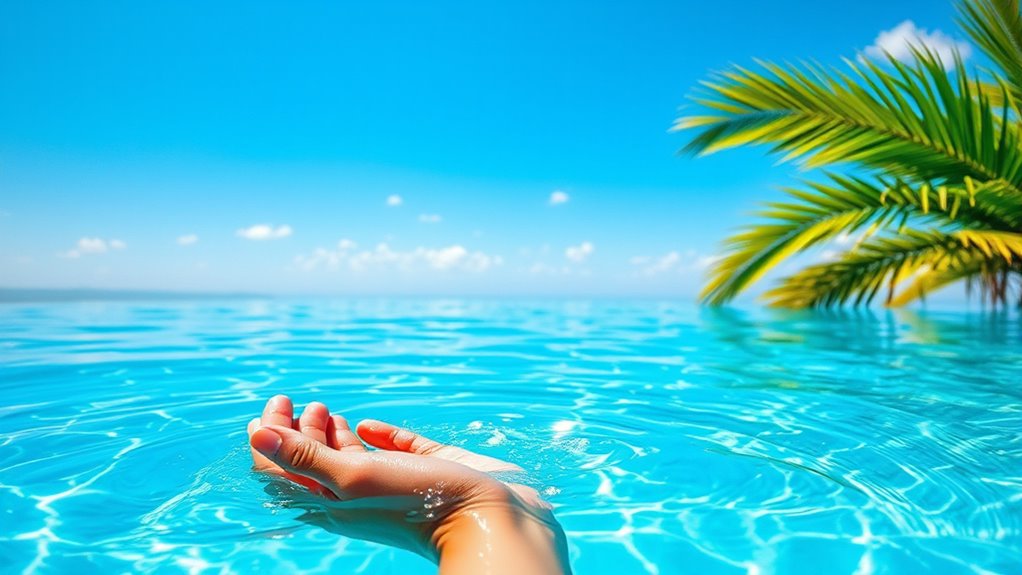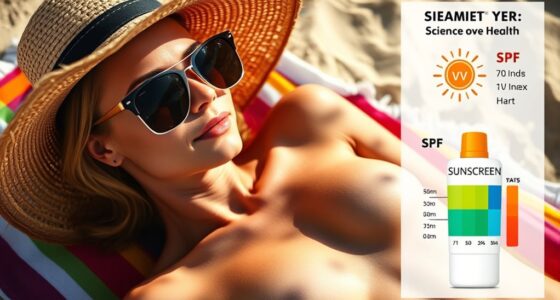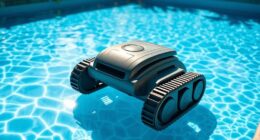Water doesn’t protect your skin from the sun. It offers minimal barrier against ultraviolet rays, which can still penetrate water and reflect off its surface, increasing exposure. Water-based sunscreens help, but they need proper reapplication and water resistance to stay effective. Relying solely on water is risky, so combining sunscreen with protective clothing, shade, and other measures provides better defense. Keep going to discover how to maximize your sun protection strategies effectively.
Key Takeaways
- Water provides minimal UV protection; UV rays can penetrate water and reflect off water surfaces, increasing skin exposure.
- Water-based sunscreens are effective but require reapplication after water contact, as their protective layer diminishes when dry.
- Water resistance in sunscreens offers temporary protection during water activities but does not make water itself protective.
- Relying solely on water or water-based sunscreens can create a false sense of security, increasing the risk of sunburn.
- Combining sunscreen, protective clothing, shade, and water awareness offers the best defense against UV damage.
Understanding the Role of Water in Sun Protection
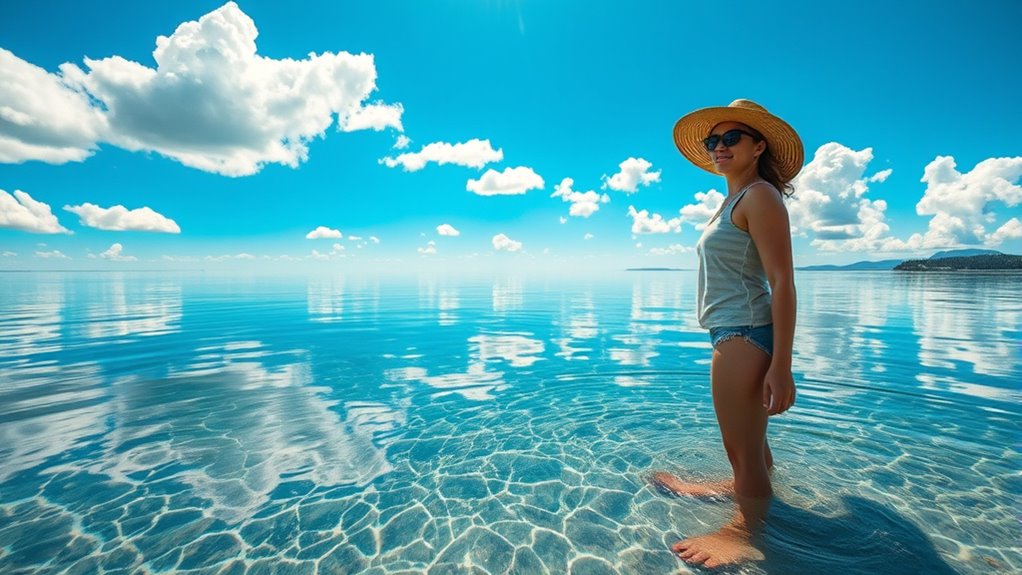
Water plays a crucial role in enhancing sun protection by serving as the base for many effective sunscreens. When you choose water-based sunscreens with SPF 50 and PA++++, you get broad-spectrum protection against UVA and UVB rays, which helps prevent premature aging and sunburn. SPF 50 blocks about 98% of UVB rays, considerably lowering your risk of sunburn, while the PA++++ rating offers the highest UVA protection. These formulations are lightweight, absorb quickly, and feel breathable, making them comfortable for daily use, even under makeup. Water-based sunscreens also resist water and sweat for a certain period, ensuring continuous protection during water activities or sweating. They don’t leave a white cast and often include hydrating ingredients, supporting both sun defense and skin health. Additionally, choosing advanced filtration technology can further improve protection against harmful UV rays. Embracing water’s role in skin care highlights how hydration and protective formulations work together to maintain skin health under sun exposure.
The Limitations of Water as a Barrier Against UV Rays
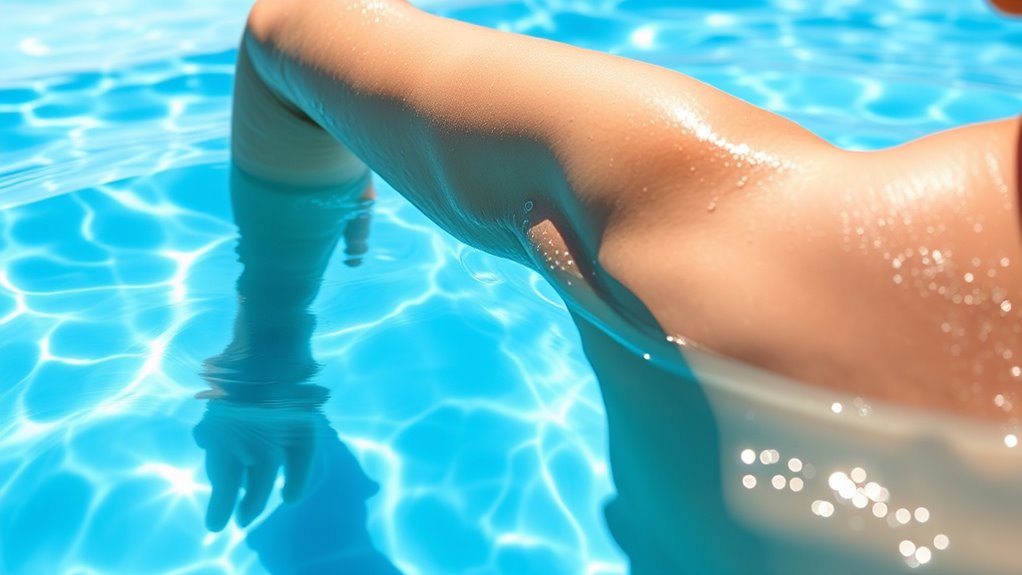
Have you ever assumed that being in water offers sufficient sun protection? Water does little to block UV rays; in fact, UV radiation can penetrate water, especially in clear or shallow areas. This means you’re still vulnerable to skin damage even when submerged. Water’s reflective surface can increase UV exposure by bouncing rays onto your skin, sometimes intensifying the risk. Turbidity or cloudiness may reduce UV penetration slightly, but these effects are unreliable and inconsistent. Water offers no lasting protection—once you dry off or leave the water, any barrier effect disappears. Additionally, water’s reflective surface can amplify UV exposure, further increasing the risk of skin damage. Relying solely on water for sun safety creates a false sense of security, leading to increased risk of sunburn, premature aging, or skin damage. Proper sunscreen and protective clothing are still essential.
Being aware of UV penetration is crucial for effective sun protection strategies, especially when engaging in water-based activities.
How Water-Based Sunscreens Work and Their Effectiveness
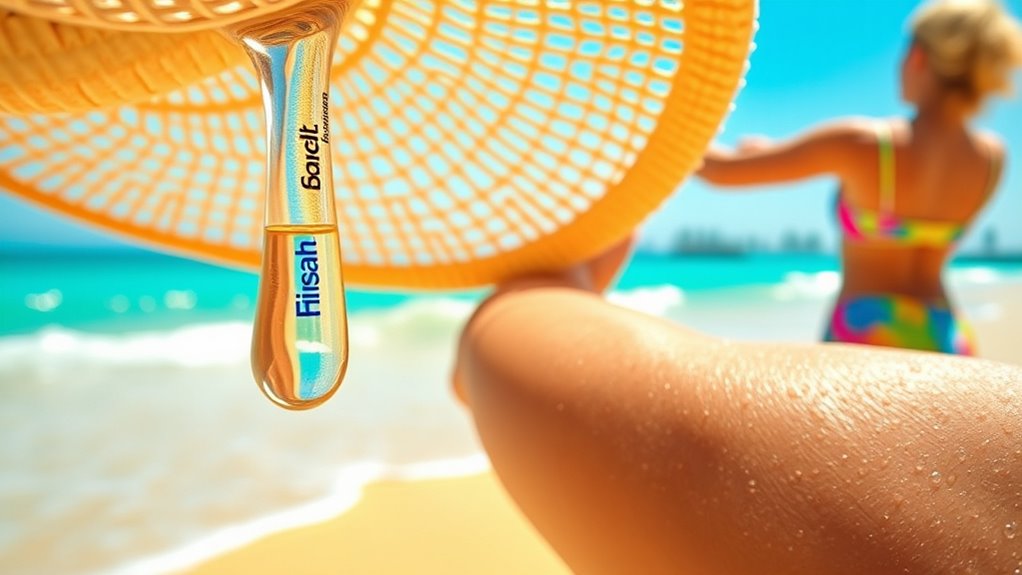
Water-based sunscreens work by quickly absorbing into your skin, providing a lightweight and comfortable layer of protection without feeling greasy or sticky. They’re formulated through an emulsification process that blends oil and water phases, creating a stable and smooth product. Key ingredients like hyaluronic acid and glycerin help keep your skin hydrated while offering UV defense. Although water-based sunscreens contain water-soluble UV filters, these may be less effective when you’re sweating or in water. Their film stability is vital for sustained protection, but they usually need reapplication after exposure to water or sweat. Understanding film stability can help you choose a sunscreen that offers reliable protection during outdoor activities, especially when combined with knowledge about protective styling benefits for your skin. Additionally, the presence of water resistance features can enhance their effectiveness during physical activity. Recognizing the importance of coating integrity in sunscreen formulations ensures you select products that maintain their protective barrier effectively. Moreover, emulsion stability is crucial to prevent separation and ensure consistent application. Overall, they deliver effective UV protection while maintaining a comfortable, non-greasy feel on your skin.
Factors That Reduce Sunscreen Performance in Water Conditions

While water-based sunscreens are designed to provide effective UV protection with a lightweight feel, their performance can be compromised during water activities. Water exposure can wash out UV filters and break down the sunscreen film, reducing protection. Sweating can cause the sunscreen to wash off or redistribute, lowering SPF levels. Friction from towel drying or clothing further diminishes effectiveness. Although hydrophobic formulations improve water resistance, they may not handle sweat well. The integrity of the sunscreen film is essential for lasting protection during water play. Additionally, the chemical makeup—such as UV filters, hydrophobic polymers, and water-absorbing particles—impacts performance. Water resistance is a key factor influencing how well the sunscreen maintains its efficacy when exposed to water. Recent advances in AI-driven research are paving the way for more durable and effective formulations that better withstand water exposure. Moreover, formulation stability plays a crucial role in ensuring consistent protection throughout water-based activities. Environmental factors like water temperature, mineral content, and wind can also influence how well your sunscreen stays effective in water conditions.
Choosing the Right Sunscreen for Water Activities
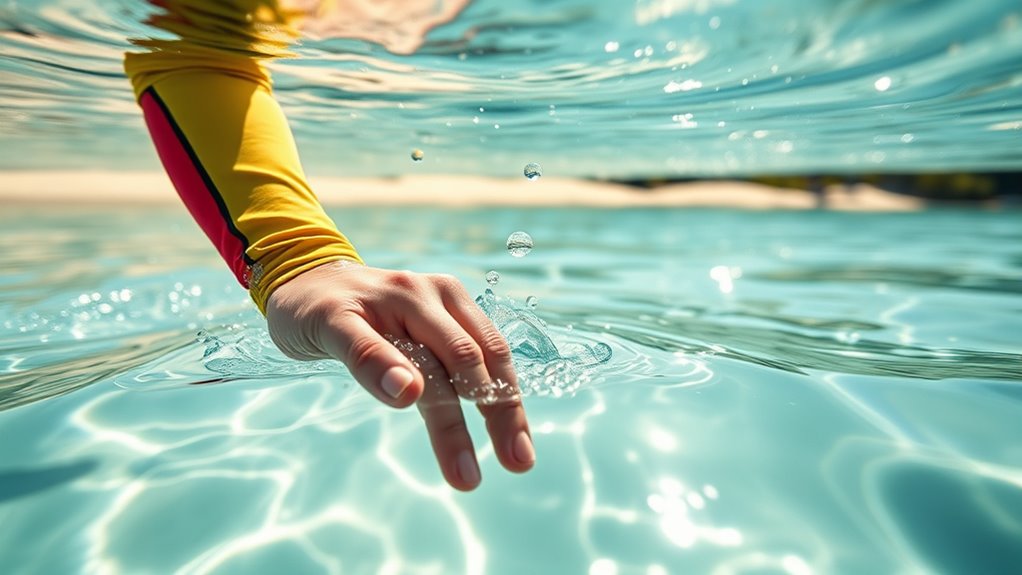
Choosing the right sunscreen for water activities requires selecting formulations specifically designed to withstand exposure to water, sweat, and friction. Look for mineral-based sunscreens with zinc oxide or titanium dioxide, as they’re effective and safe for aquatic environments. Water-resistant, sport-specific formulas are ideal—they maintain protection during vigorous movement and water immersion, often lasting 40 to 80 minutes before reapplication. Consider reef-friendly options that avoid harmful chemicals like oxybenzone, protecting marine life. Tinted mineral sunscreens offer added coverage and skin tone evening benefits while being suitable for water use. Ingredients like zinc oxide above 20%, natural oils, and non-nano particles enhance water resistance and minimize environmental impact. Choose lightweight, non-greasy textures, and formats like sprays or sticks for easier application on wet skin. Additionally, understanding water resistance helps in selecting the most effective sunscreen for aquatic environments. Recognizing sound design principles can also aid in creating engaging educational content about sun safety.
The Importance of Reapplication and Water Resistance

Since water doesn’t absorb UV rays but can wash away sunscreen, reapplication is vital during water activities. Even if you’re in the water, your skin remains vulnerable to UV damage, so you need to reapply sunscreen frequently. Water-resistant formulas help, but they only last for a limited time—usually 40 or 80 minutes—and can lose effectiveness after swimming or towel drying. Remember, no sunscreen is completely waterproof, so reapplying after water exposure is essential. During outdoor activities, you should reapply every two hours or sooner if you notice signs of reduced protection, like dryness or skin redness. Proper reapplication involves covering all exposed areas thoroughly to maintain a strong barrier against UV rays, ensuring your skin stays protected throughout your time in the sun. Incorporating proper application techniques can further enhance sunscreen effectiveness and prevent missed spots, especially when considering water resistance or strategies for investing in high-quality skincare products. Additionally, understanding sunscreen labels can help you choose products that offer the best protection for water-related activities.
Enhancing Skin Protection Beyond Water Exposure

Protecting your skin from the sun requires more than just applying sunscreen, especially when water exposure isn’t enough to block UV rays. Wearing protective clothing, like long sleeves, pants, wide-brimmed hats, and UV-blocking sunglasses, creates physical barriers that reduce direct UV contact. Seeking shade under trees, umbrellas, or canopies helps limit peak sun exposure, but reflections from surfaces can still reach your skin. Using broad-spectrum sunscreens with SPF 20–30 and applying them properly 15 minutes before sun exposure enhances protection. Combining these strategies with antioxidants in skincare or diet further reduces UV damage. Remember, no single method is foolproof, so adopting a thorough approach—clothing, shade, sunscreen, and antioxidants—best shields your skin from harmful rays. Incorporating environmental considerations ensures your sun protection practices are sustainable and respectful of natural ecosystems. Additionally, some skincare products like Pimple Patches can aid in healing skin affected by sun exposure and acne, complementing your overall skin health routine. It is also beneficial to be aware of Home Furnishings that can influence indoor UV exposure, such as window treatments that block or filter UV rays. Furthermore, understanding PlayStation support hours and other entertainment venue schedules can help you plan outdoor activities during optimal times with less sun intensity, reducing your risk of UV damage.
Frequently Asked Questions
Can Water-Based Sunscreens Be More Environmentally Friendly Than Traditional Options?
You might wonder if water-based sunscreens are better for the environment. They typically use mineral UV filters like zinc oxide or titanium dioxide, which are less toxic to marine life than chemical filters. By choosing water-based options, you reduce the risk of polluting waterways, coral reef damage, and bioaccumulation in marine organisms. This makes them a more eco-friendly choice, especially in sensitive coastal areas.
Are Mineral or Chemical Sunscreens Better for Water Activities?
This question is more important than ever, considering how much you love water adventures! When it comes to water activities, mineral sunscreens are your best bet—they work immediately, are reef-safe, and resist water for up to 80 minutes. Chemical sunscreens, while easier to apply, tend to wash off quickly and may harm marine life. For prolonged water fun, mineral options keep you protected and eco-friendly.
How Does Skin Type Influence Sunscreen Effectiveness in Water?
You might wonder how your skin type affects sunscreen effectiveness in water. For oily skin, water-based sunscreens work well because they’re lightweight and less greasy, making reapplication easier. Dry skin benefits from moisturizing formulas that stay on longer. Sensitive skin responds best to physical filters like zinc oxide. If you have acne-prone skin, choose non-comedogenic, water-based options. Remember, reapplying frequently is key, especially during water activities.
Do Certain Ingredients in Sunscreens Improve Water Resistance?
You might wonder if certain ingredients boost water resistance in sunscreens. Ingredients like beeswax, mineral filters such as zinc oxide and titanium dioxide, and film-forming polymers create a durable barrier that sticks to your skin and resists washing off. Adding plant oils, alcohol, or specialized polymers helps strengthen this layer, ensuring your sunscreen stays effective longer, especially when you’re swimming or sweating.
Is There a Difference in UV Protection Between Spray and Lotion Sunscreens in Water?
Think of spray and lotion sunscreens like two runners in a race—they both aim for the same finish line: UV protection. In water, both offer equally effective protection when applied correctly and labeled as water-resistant. However, sprays can be blown away by wind, risking uneven coverage, while lotions stick better. So, choose a lotion if you want consistent, reliable protection, especially in wet conditions, and reapply regularly.
Conclusion
So, next time you’re at the beach, don’t rely on water alone to shield your skin. Imagine diving into the waves, thinking you’re protected, only to realize UV rays are still sneaking through. Water may wash away some sunscreen, but true defense comes from choosing the right, water-resistant products and reapplying diligently. Stay vigilant—your skin’s safety depends on it, even when you’re immersed in the water’s revitalizing embrace.
